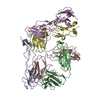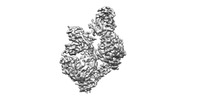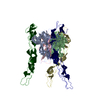[English] 日本語
 Yorodumi
Yorodumi- EMDB-34871: Cryo-EM structure of biparatopic antibody Bp109-92 in complex wit... -
+ Open data
Open data
- Basic information
Basic information
| Entry |  | |||||||||||||||||||||||||||||||||
|---|---|---|---|---|---|---|---|---|---|---|---|---|---|---|---|---|---|---|---|---|---|---|---|---|---|---|---|---|---|---|---|---|---|---|
| Title | Cryo-EM structure of biparatopic antibody Bp109-92 in complex with TNFR2 | |||||||||||||||||||||||||||||||||
 Map data Map data | ||||||||||||||||||||||||||||||||||
 Sample Sample |
| |||||||||||||||||||||||||||||||||
 Keywords Keywords | TNFR2 / biparatopic antibody /  antagonist / antagonist /  IMMUNE SYSTEM IMMUNE SYSTEM | |||||||||||||||||||||||||||||||||
| Function / homology |  Function and homology information Function and homology informationglial cell-neuron signaling / regulation of cytokine production involved in immune response /  tumor necrosis factor receptor superfamily complex / pulmonary valve development / RNA destabilization / aortic valve development / tumor necrosis factor receptor superfamily complex / pulmonary valve development / RNA destabilization / aortic valve development /  tumor necrosis factor receptor activity / negative regulation of extracellular matrix constituent secretion / positive regulation of apoptotic process involved in morphogenesis / regulation of T cell cytokine production ...glial cell-neuron signaling / regulation of cytokine production involved in immune response / tumor necrosis factor receptor activity / negative regulation of extracellular matrix constituent secretion / positive regulation of apoptotic process involved in morphogenesis / regulation of T cell cytokine production ...glial cell-neuron signaling / regulation of cytokine production involved in immune response /  tumor necrosis factor receptor superfamily complex / pulmonary valve development / RNA destabilization / aortic valve development / tumor necrosis factor receptor superfamily complex / pulmonary valve development / RNA destabilization / aortic valve development /  tumor necrosis factor receptor activity / negative regulation of extracellular matrix constituent secretion / positive regulation of apoptotic process involved in morphogenesis / regulation of T cell cytokine production / varicosity / negative regulation of neuroinflammatory response / tumor necrosis factor receptor activity / negative regulation of extracellular matrix constituent secretion / positive regulation of apoptotic process involved in morphogenesis / regulation of T cell cytokine production / varicosity / negative regulation of neuroinflammatory response /  tumor necrosis factor binding / TNFs bind their physiological receptors / negative regulation of cardiac muscle hypertrophy / positive regulation of myelination / regulation of neuroinflammatory response / positive regulation of membrane protein ectodomain proteolysis / tumor necrosis factor binding / TNFs bind their physiological receptors / negative regulation of cardiac muscle hypertrophy / positive regulation of myelination / regulation of neuroinflammatory response / positive regulation of membrane protein ectodomain proteolysis /  regulation of myelination / positive regulation of oligodendrocyte differentiation / detection of maltose stimulus / regulation of myelination / positive regulation of oligodendrocyte differentiation / detection of maltose stimulus /  maltose binding / maltose transport complex / regulation of T cell proliferation / maltose transport / maltodextrin transmembrane transport / Interleukin-10 signaling / carbohydrate transmembrane transporter activity / ATP-binding cassette (ABC) transporter complex, substrate-binding subunit-containing / carbohydrate transport / specific granule membrane / extrinsic apoptotic signaling pathway / tumor necrosis factor-mediated signaling pathway / ATP-binding cassette (ABC) transporter complex / cell chemotaxis / TNFR2 non-canonical NF-kB pathway / cellular response to growth factor stimulus / intrinsic apoptotic signaling pathway in response to DNA damage / outer membrane-bounded periplasmic space / Interleukin-4 and Interleukin-13 signaling / cellular response to lipopolysaccharide / maltose binding / maltose transport complex / regulation of T cell proliferation / maltose transport / maltodextrin transmembrane transport / Interleukin-10 signaling / carbohydrate transmembrane transporter activity / ATP-binding cassette (ABC) transporter complex, substrate-binding subunit-containing / carbohydrate transport / specific granule membrane / extrinsic apoptotic signaling pathway / tumor necrosis factor-mediated signaling pathway / ATP-binding cassette (ABC) transporter complex / cell chemotaxis / TNFR2 non-canonical NF-kB pathway / cellular response to growth factor stimulus / intrinsic apoptotic signaling pathway in response to DNA damage / outer membrane-bounded periplasmic space / Interleukin-4 and Interleukin-13 signaling / cellular response to lipopolysaccharide /  periplasmic space / periplasmic space /  immune response / immune response /  inflammatory response / inflammatory response /  membrane raft / neuronal cell body / DNA damage response / membrane raft / neuronal cell body / DNA damage response /  ubiquitin protein ligase binding / Neutrophil degranulation / perinuclear region of cytoplasm / extracellular region / ubiquitin protein ligase binding / Neutrophil degranulation / perinuclear region of cytoplasm / extracellular region /  membrane / membrane /  plasma membrane plasma membraneSimilarity search - Function | |||||||||||||||||||||||||||||||||
| Biological species |   Homo sapiens (human) / Homo sapiens (human) /   Escherichia coli (strain K12) (bacteria) Escherichia coli (strain K12) (bacteria) | |||||||||||||||||||||||||||||||||
| Method |  single particle reconstruction / single particle reconstruction /  cryo EM / Resolution: 3.63 Å cryo EM / Resolution: 3.63 Å | |||||||||||||||||||||||||||||||||
 Authors Authors | Akiba H / Fujita J / Ise T / Nishiyama K / Miyata T / Kato T / Namba K / Ohno H / Kamada H / Nagata S / Tsumoto K | |||||||||||||||||||||||||||||||||
| Funding support |  Japan, 10 items Japan, 10 items
| |||||||||||||||||||||||||||||||||
 Citation Citation |  Journal: Commun Biol / Year: 2023 Journal: Commun Biol / Year: 2023Title: Development of a 1:1-binding biparatopic anti-TNFR2 antagonist by reducing signaling activity through epitope selection. Authors: Hiroki Akiba / Junso Fujita / Tomoko Ise / Kentaro Nishiyama / Tomoko Miyata / Takayuki Kato / Keiichi Namba / Hiroaki Ohno / Haruhiko Kamada / Satoshi Nagata / Kouhei Tsumoto /  Abstract: Conventional bivalent antibodies against cell surface receptors often initiate unwanted signal transduction by crosslinking two antigen molecules. Biparatopic antibodies (BpAbs) bind to two different ...Conventional bivalent antibodies against cell surface receptors often initiate unwanted signal transduction by crosslinking two antigen molecules. Biparatopic antibodies (BpAbs) bind to two different epitopes on the same antigen, thus altering crosslinking ability. In this study, we develop BpAbs against tumor necrosis factor receptor 2 (TNFR2), which is an attractive immune checkpoint target. Using different pairs of antibody variable regions specific to topographically distinct TNFR2 epitopes, we successfully regulate the size of BpAb-TNFR2 immunocomplexes to result in controlled agonistic activities. Our series of results indicate that the relative positions of the two epitopes recognized by the BpAb are critical for controlling its signaling activity. One particular antagonist, Bp109-92, binds TNFR2 in a 1:1 manner without unwanted signal transduction, and its structural basis is determined using cryo-electron microscopy. This antagonist suppresses the proliferation of regulatory T cells expressing TNFR2. Therefore, the BpAb format would be useful in designing specific and distinct antibody functions. | |||||||||||||||||||||||||||||||||
| History |
|
- Structure visualization
Structure visualization
| Supplemental images |
|---|
- Downloads & links
Downloads & links
-EMDB archive
| Map data |  emd_34871.map.gz emd_34871.map.gz | 59.6 MB |  EMDB map data format EMDB map data format | |
|---|---|---|---|---|
| Header (meta data) |  emd-34871-v30.xml emd-34871-v30.xml emd-34871.xml emd-34871.xml | 24 KB 24 KB | Display Display |  EMDB header EMDB header |
| FSC (resolution estimation) |  emd_34871_fsc.xml emd_34871_fsc.xml | 8.4 KB | Display |  FSC data file FSC data file |
| Images |  emd_34871.png emd_34871.png | 34.3 KB | ||
| Masks |  emd_34871_msk_1.map emd_34871_msk_1.map | 64 MB |  Mask map Mask map | |
| Filedesc metadata |  emd-34871.cif.gz emd-34871.cif.gz | 7.3 KB | ||
| Others |  emd_34871_half_map_1.map.gz emd_34871_half_map_1.map.gz emd_34871_half_map_2.map.gz emd_34871_half_map_2.map.gz | 59.5 MB 59.5 MB | ||
| Archive directory |  http://ftp.pdbj.org/pub/emdb/structures/EMD-34871 http://ftp.pdbj.org/pub/emdb/structures/EMD-34871 ftp://ftp.pdbj.org/pub/emdb/structures/EMD-34871 ftp://ftp.pdbj.org/pub/emdb/structures/EMD-34871 | HTTPS FTP |
-Related structure data
| Related structure data |  8hlbMC M: atomic model generated by this map C: citing same article ( |
|---|---|
| Similar structure data | Similarity search - Function & homology  F&H Search F&H Search |
- Links
Links
| EMDB pages |  EMDB (EBI/PDBe) / EMDB (EBI/PDBe) /  EMDataResource EMDataResource |
|---|---|
| Related items in Molecule of the Month |
- Map
Map
| File |  Download / File: emd_34871.map.gz / Format: CCP4 / Size: 64 MB / Type: IMAGE STORED AS FLOATING POINT NUMBER (4 BYTES) Download / File: emd_34871.map.gz / Format: CCP4 / Size: 64 MB / Type: IMAGE STORED AS FLOATING POINT NUMBER (4 BYTES) | ||||||||||||||||||||
|---|---|---|---|---|---|---|---|---|---|---|---|---|---|---|---|---|---|---|---|---|---|
| Voxel size | X=Y=Z: 1.0875 Å | ||||||||||||||||||||
| Density |
| ||||||||||||||||||||
| Symmetry | Space group: 1 | ||||||||||||||||||||
| Details | EMDB XML:
|
-Supplemental data
-Mask #1
| File |  emd_34871_msk_1.map emd_34871_msk_1.map | ||||||||||||
|---|---|---|---|---|---|---|---|---|---|---|---|---|---|
| Projections & Slices |
| ||||||||||||
| Density Histograms |
-Half map: #2
| File | emd_34871_half_map_1.map | ||||||||||||
|---|---|---|---|---|---|---|---|---|---|---|---|---|---|
| Projections & Slices |
| ||||||||||||
| Density Histograms |
-Half map: #1
| File | emd_34871_half_map_2.map | ||||||||||||
|---|---|---|---|---|---|---|---|---|---|---|---|---|---|
| Projections & Slices |
| ||||||||||||
| Density Histograms |
- Sample components
Sample components
-Entire : Cryo-EM structure of biparatopic antibody Bp109-92 in complex wit...
| Entire | Name: Cryo-EM structure of biparatopic antibody Bp109-92 in complex with TNFR2 |
|---|---|
| Components |
|
-Supramolecule #1: Cryo-EM structure of biparatopic antibody Bp109-92 in complex wit...
| Supramolecule | Name: Cryo-EM structure of biparatopic antibody Bp109-92 in complex with TNFR2 type: complex / ID: 1 / Parent: 0 / Macromolecule list: all |
|---|---|
| Source (natural) | Organism:   Homo sapiens (human) Homo sapiens (human) |
-Macromolecule #1: Tumor necrosis factor receptor superfamily member 1B,Maltose/malt...
| Macromolecule | Name: Tumor necrosis factor receptor superfamily member 1B,Maltose/maltodextrin-binding periplasmic protein type: protein_or_peptide / ID: 1 Details: fusion protein of TNFR2 from human fused with MalE from E.Coli K-12 Number of copies: 1 / Enantiomer: LEVO |
|---|---|
| Source (natural) | Organism:   Escherichia coli (strain K12) (bacteria) Escherichia coli (strain K12) (bacteria) |
| Molecular weight | Theoretical: 60.447305 KDa |
| Recombinant expression | Organism:   Homo sapiens (human) Homo sapiens (human) |
| Sequence | String: LPAQVAFTPY APEPGSTCRL REYYDQTAQM CCSKCSPGQH AKVFCTKTSD TVCDSCEDST YTQLWNWVPE CLSCGSRCSS DQVETQACT REQNRICTCR PGWYCALSKQ EGCRLCAPLR KCRPGFGVAR PGTETSDVVC KPCAPGTFSN TTSSTDICRP H QICNVVAI ...String: LPAQVAFTPY APEPGSTCRL REYYDQTAQM CCSKCSPGQH AKVFCTKTSD TVCDSCEDST YTQLWNWVPE CLSCGSRCSS DQVETQACT REQNRICTCR PGWYCALSKQ EGCRLCAPLR KCRPGFGVAR PGTETSDVVC KPCAPGTFSN TTSSTDICRP H QICNVVAI PGNASMDAVC KIEEGKLVIW INGDKGYNGL AEVGKKFEKD TGIKVTVEHP DKLEEKFPQV AATGDGPDII FW AHDRFGG YAQSGLLAEI TPDKAFQDKL YPFTWDAVRY NGKLIAYPIA VEALSLIYNK DLLPNPPKTW EEIPALDKEL KAK GKSALM FNLQEPYFTW PLIAADGGYA FKYENGKYDI KDVGVDNAGA KAGLTFLVDL IKNKHMNADT DYSIAEAAFN KGET AMTIN GPWAWSNIDT SKVNYGVTVL PTFKGQPSKP FVGVLSAGIN AASPNKELAK EFLENYLLTD EGLEAVNKDK PLGAV ALKS YEEELVKDPR IAATMENAQK GEIMPNIPQM SAFWYAVRTA VINAASGRQT VDEALKDAQG HHHHHH UniProtKB: Tumor necrosis factor receptor superfamily member 1B, Maltose/maltodextrin-binding periplasmic protein |
-Macromolecule #2: TR109 heavy chain
| Macromolecule | Name: TR109 heavy chain / type: protein_or_peptide / ID: 2 / Number of copies: 1 / Enantiomer: LEVO |
|---|---|
| Source (natural) | Organism:   Homo sapiens (human) Homo sapiens (human) |
| Molecular weight | Theoretical: 25.080273 KDa |
| Recombinant expression | Organism:   Homo sapiens (human) Homo sapiens (human) |
| Sequence | String: QVQLKESGPG LVAPSQSLSI TCTVSGFSLT VYGVNWVRQP PGKGLEWLGM IWGDGSTAYN SALKSRLTIT KDNSKTQVFL KMNSLQTDD TARYYCARDG RRYALDYWGQ GTSVTVSSAS TKGPSVFPLA PSSKSTSGGT AALGCLVKDY FPEPVTVSWN S GALTSGVH ...String: QVQLKESGPG LVAPSQSLSI TCTVSGFSLT VYGVNWVRQP PGKGLEWLGM IWGDGSTAYN SALKSRLTIT KDNSKTQVFL KMNSLQTDD TARYYCARDG RRYALDYWGQ GTSVTVSSAS TKGPSVFPLA PSSKSTSGGT AALGCLVKDY FPEPVTVSWN S GALTSGVH TFPAVLQSSG LYSLSSVVTV PSSSLGTQTY ICNVNHKPSN TKVDKKVEPK SCFNTHTCPP CPAPELLG |
-Macromolecule #3: TR109 light chain
| Macromolecule | Name: TR109 light chain / type: protein_or_peptide / ID: 3 / Number of copies: 1 / Enantiomer: LEVO |
|---|---|
| Source (natural) | Organism:   Homo sapiens (human) Homo sapiens (human) |
| Molecular weight | Theoretical: 23.852311 KDa |
| Recombinant expression | Organism:   Homo sapiens (human) Homo sapiens (human) |
| Sequence | String: DIVLTQSPTS LAVSLGQRAT ISCRASESVD SYGDSFLHWY QQKPGQPPIL LIYRASNLDS GIPARFSGSG SRTDFTLTIN PVEADDVAT YYCQQSNEDP YTFGGGTKLE IKRTVAAPSV FIFPPSDEQL KSGTASVVCL LNNFYPREAK VQWKVDNALQ S GNSQESVT ...String: DIVLTQSPTS LAVSLGQRAT ISCRASESVD SYGDSFLHWY QQKPGQPPIL LIYRASNLDS GIPARFSGSG SRTDFTLTIN PVEADDVAT YYCQQSNEDP YTFGGGTKLE IKRTVAAPSV FIFPPSDEQL KSGTASVVCL LNNFYPREAK VQWKVDNALQ S GNSQESVT EQDSKDSTYS LSSTLTLSKA DYEKHKVYAC EVTHQGLSSP VTKSFNRGEC |
-Macromolecule #4: TR92 heavy chain
| Macromolecule | Name: TR92 heavy chain / type: protein_or_peptide / ID: 4 / Number of copies: 1 / Enantiomer: LEVO |
|---|---|
| Source (natural) | Organism:   Homo sapiens (human) Homo sapiens (human) |
| Molecular weight | Theoretical: 25.543641 KDa |
| Recombinant expression | Organism:   Homo sapiens (human) Homo sapiens (human) |
| Sequence | String: KVQLQQSGAE LVKPGASVKL SCKASGYTFT ESIIHWVKQR SGQGLEWIGW FYPGSDNINY NEKFKDKATL TADKSSSTVY MELTRLTSE DSAVYFCASH EGPYVYFDYW GQGTTLTVSS ASTKGPSVFP LAPSSKSTSG GTAALGCLVK DYFPEPVTVS W NSGALTSG ...String: KVQLQQSGAE LVKPGASVKL SCKASGYTFT ESIIHWVKQR SGQGLEWIGW FYPGSDNINY NEKFKDKATL TADKSSSTVY MELTRLTSE DSAVYFCASH EGPYVYFDYW GQGTTLTVSS ASTKGPSVFP LAPSSKSTSG GTAALGCLVK DYFPEPVTVS W NSGALTSG VHTFPAVLQS SGLYSLSSVV TVPSSSLGTQ TYICNVNHKP SNTKVDKKVE PKSCDKTHTC PPCPAPELLG |
-Macromolecule #5: TR92 light chain
| Macromolecule | Name: TR92 light chain / type: protein_or_peptide / ID: 5 / Number of copies: 1 / Enantiomer: LEVO |
|---|---|
| Source (natural) | Organism:   Homo sapiens (human) Homo sapiens (human) |
| Molecular weight | Theoretical: 23.590156 KDa |
| Recombinant expression | Organism:   Homo sapiens (human) Homo sapiens (human) |
| Sequence | String: DIVMTQSHKF MSTSVGDRVS ITCKASQDVS TAVAWYQQKP GQSPKLLIYW TSTRHTGVPD RFTGSGSGTD YTLTISSVQA EDLALYYCQ HHYSTPYTFG GGTKLEIQRT VAAPSVFIFP PSDEQLKSGT ASVVCLLNNF YPREAKVQWK VDNALQSGNS Q ESVTEQDS ...String: DIVMTQSHKF MSTSVGDRVS ITCKASQDVS TAVAWYQQKP GQSPKLLIYW TSTRHTGVPD RFTGSGSGTD YTLTISSVQA EDLALYYCQ HHYSTPYTFG GGTKLEIQRT VAAPSVFIFP PSDEQLKSGT ASVVCLLNNF YPREAKVQWK VDNALQSGNS Q ESVTEQDS KDSTYSLSST LTLSKADYEK HKVYACEVTH QGLSSPVTKS FNRGEC |
-Experimental details
-Structure determination
| Method |  cryo EM cryo EM |
|---|---|
 Processing Processing |  single particle reconstruction single particle reconstruction |
| Aggregation state | particle |
- Sample preparation
Sample preparation
| Concentration | 0.2 mg/mL |
|---|---|
| Buffer | pH: 7.4 / Details: 1x PBS |
| Grid | Model: Quantifoil R1.2/1.3 / Material: COPPER / Mesh: 200 / Pretreatment - Type: GLOW DISCHARGE / Pretreatment - Time: 20 sec. / Pretreatment - Atmosphere: AIR / Details: 20 mA |
| Vitrification | Cryogen name: ETHANE / Instrument: FEI VITROBOT MARK IV |
- Electron microscopy
Electron microscopy
| Microscope | JEOL CRYO ARM 300 |
|---|---|
| Electron beam | Acceleration voltage: 300 kV / Electron source:  FIELD EMISSION GUN FIELD EMISSION GUN |
| Electron optics | Illumination mode: FLOOD BEAM / Imaging mode: BRIGHT FIELD Bright-field microscopy / Cs: 2.7 mm / Nominal defocus max: 2.0 µm / Nominal defocus min: 0.5 µm / Nominal magnification: 60000 Bright-field microscopy / Cs: 2.7 mm / Nominal defocus max: 2.0 µm / Nominal defocus min: 0.5 µm / Nominal magnification: 60000 |
| Specialist optics | Energy filter - Name: In-column Omega Filter / Energy filter - Slit width: 20 eV |
| Sample stage | Specimen holder model: JEOL CRYOSPECPORTER / Cooling holder cryogen: NITROGEN |
| Image recording | Film or detector model: GATAN K3 (6k x 4k) / Number grids imaged: 1 / Average exposure time: 4.9 sec. / Average electron dose: 60.0 e/Å2 |
 Movie
Movie Controller
Controller









 Z
Z Y
Y X
X



























